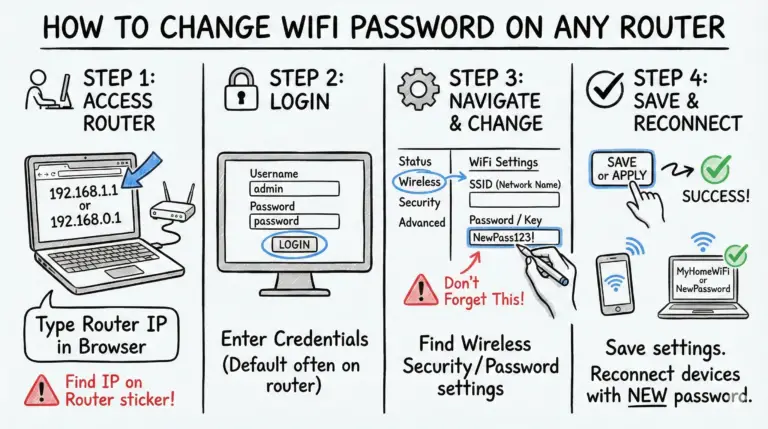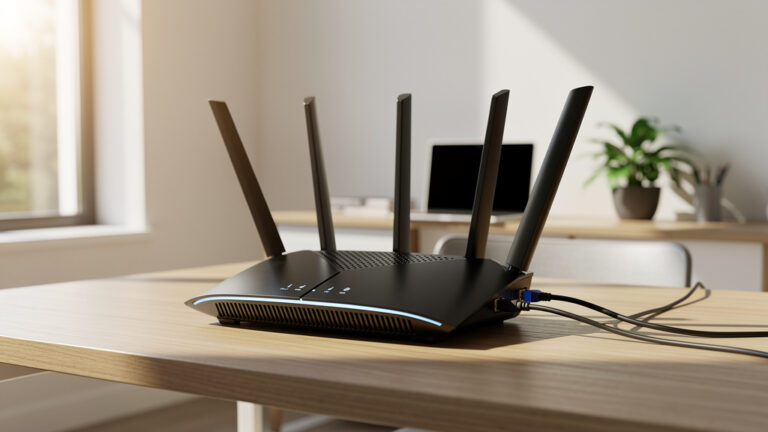Comparing the ARRIS SB8200 vs Motorola MB8600 cable modems? Both are great for high-speed internet but differ in price and some features. The SB8200 is cheaper with two Ethernet ports, while the MB8600 has faster speeds with channel-bonding. We’ll discuss speed, specs, design, and compatibility to help you choose the right one.
Quick Verdict: ARRIS SB8200 vs Motorola MB8600
The ARRIS SB8200 and Motorola MB8600 are both excellent DOCSIS 3.1 cable modems capable of multi-gigabit speeds. The SB8200 is more affordable and has two ports, while the MB8600 has channel-bonding capability for faster potential speeds. For most home users, the SB8200 offers the best value.


ARRIS SB8200 vs Motorola MB8600: Key Features
| Feature | ARRIS SB8200 | Motorola MB8600 |
|---|---|---|
| Max Speed | 1Gbps | 6Gbps |
| Ethernet Ports | 2 x 1Gbps | 1 x 1Gbps |
| Channels | 32×8 | 32×8 + 32×8 |
| WiFi Router | No | No |
| Price | $140 approx | $190 approx |
The Key Differences – SB8200 vs MB8600
- Speed – The Motorola MB8600 has a higher maximum speed of nearly 6Gbps compared to 1Gbps on the SB8200 due its dual DOCSIS 3.1 and 3.0 chipsets. However, most cable internet plans currently don’t exceed gigabit speeds.
- Ports – The SB8200 includes two 1Gbps Ethernet ports allowing you to connect more wired devices directly or add a second IP. The MB8600 only has one port.
- Future-proofing – The MB8600 may have more headroom for future speed increases with its dual 32×8 channel bonding capability. But the SB8200’s 32×8 channels will still handle forthcoming gigabit+ plans.
- Price – The ARRIS SB8200 costs around $140 while the Motorola MB8600 is typically $190. Given the small performance differences, the SB8200 gives better value.
Similarities – SB8200 vs MB8600
- Easy setup – Both are plug and play modems without built-in routers that allow self-activation.
- Compatibility – They are compatible with major cable ISPs like Comcast Xfinity, Spectrum and Cox.
- Reliability – ARRIS and Motorola make quality networking products that are stable and reliable.
- No built-in router – You’ll need to add your own wireless router for WiFi connectivity.
Who Should Buy the ARRIS SB8200?
The ARRIS SB8200 is the best choice if you want an affordable and reliable modem for gigabit Internet speeds without paying a lot extra for higher speeds you may not fully utilize. It has all the essential features and performance needed for smooth 4K streaming, online gaming, video calls and smart home connectivity.
Who Should Buy the Motorola MB8600?
The Motorola MB8600 is a good option if you want some additional headroom and future-proofing. Its dual DOCSIS 3.1 and 3.0 chipsets allow theoretical speeds up to 6Gbps. This makes it ideally suited if you have or intend to upgrade to a multi-gig plan (faster than 1Gbps) available now or in the near future.
Verdict:
For most home users, the ARRIS SB8200 DOCSIS 3.1 modem provides an ideal blend of affordability and performance. But if you have specific needs for faster multi-gigabit speeds, the Motorola MB8600 is a great choice albeit at a premium.


See also: Netgear CM2000 Review: Top High-Speed Cable Modem
ARRIS SB8200 vs Motorola MB8600: In-Depth Comparison
Now let’s take a deeper, more detailed look at how these two cable modems stack up across various factors:
Speed and Performance
When it comes to raw speed, the Motorola MB8600 has a clear edge with its unique dual DOCSIS 3.1 and 3.0 chipsets, allowing up to 6Gbps downloads and 1Gbps uploads. The ARRIS SB8200 maxes out at 1Gbps down and 200Mbps up.
However, you likely won’t see real-world speeds approaching those limits on either modem. Most cable Internet providers currently offer plans up to 1Gbps. And your actual speeds depend on factors like distance to node, network capacity, WiFi router and connected devices.
So why pay extra for the MB8600? Future-proofing. We’re on the cusp of a new era of multi-gigabit internet powered by DOCSIS 3.1 technology. If available in your area, you’ll be able to take full advantage of 2Gbps, 5Gbps or even 8Gbps cable plans for low latency 4K/8K streaming and VR gaming as they roll out.
But even without those bleeding edge speeds, both modems deliver enough performance for smooth video streaming, low-latency online gaming, fast file downloads, and high-quality video conferencing – the key uses for most households.
The ARRIS SB8200 and Motorola MB8600 also utilize Active Queue Management (AQM) for reduced buffer bloat and lag with interactive applications like online gaming and video calls.
Hardware Specs
The Motorola MB8600 packs some premium hardware under the hood to enable its blazing-fast speeds:
- Broadcom BCM3390 + BCM34208 chipsets
- 256MB RAM + 128MB NAND flash storage
That gives you both Docsis 3.1 and Docsis 3.0 adapters. And abundant memory to maximize use of all its 32 downstream x 8 upstream channels for 32×8 and 32×8 bonded channel.
The ARRIS SB8200 isn’t far behind with a BCM3390 chipset, 3GB RAM and similar flash storage. That 32×8 channel support still unlocks gigabit+ potential.
As for Ethernet ports, the SB8200 includes two 1Gbps LAN ports allowing you to either connect two devices directly like a computer and game console. Or provision an extra public IP address for better traffic management.
The MB8600 has a single Gigabit LAN port which is fine for most as you’ll be connecting a high-speed router anyway. But limits options for direct connections or dual IP allocation.
Design and Interface
Physically, both modems have a clean, minimalist white plastic design. The ARRIS SB8200 measures 5.2” x 5.1” x 1.8” while the Motorola MB8600 is slightly larger at 7.9” x 7.3” x 2.3″. So, neither will take up much space.
The interface makes activation and configuration a breeze for both. Once connected, you can use either the SURFboard app for SB8200 or web UI to check status, change settings and run speed tests.
Both also have color-coded status LEDs on the front, letting you check power, upstream, downstream, Internet, and Ethernet connectivity at a glance. So you easily know if something’s not working properly.
As DOCSIS 3.1 cable modems, setup is simply a matter of connecting the coaxial cable from your ISP line, power cord and Ethernet cable to your router or computer. No landline connections required.
After adding the unique MAC address to register the new device, both modems allow self-activation by your provider. Then, you simply need to connect to your existing WiFi or via Ethernet to start surfing. No technician visit is required.
ISP Compatibility
You won’t have any issues using either modem with major cable Internet providers that offer DOCSIS 3.1. This includes Xfinity, Cox, Spectrum, Optimum, and many others – provided you’re on an eligible plan.
Both ARRIS and Motorola have a long track record delivering networking equipment to ISPs. So, even smaller regional cable companies will recognize these brands and quickly provision them.
However, fiber optic networks like Verizon Fios use different technologies and wiring so these DOCSIS 3.1 modems cannot replace the ONT equipment they supply directly.
Reliability
Customers praise both ARRIS and Motorola for making reliable modems that deliver solid, consistent performance. These are blue-chip brands trusted by the big ISPs, so quality assurance testing is stringent before any product launch.
Once up and running, owners love the stable connections with fast sustained speeds and almost no random dropouts for either modem. That lag-free reliability is critical for gaming, streaming 4K video and all sorts of smart home devices from video doorbells to robots vacuums managing your digital domain seamlessly.
For most, both modems deliver on plug-and-play simplicity with basic installation and minimal crashes requiring rebooting. But a minority do complain connectivity issues occasionally requiring power cycling.


Security
Cyber attacks exploiting home routers and devices are on the rise. So having firewalls and threat monitoring in place is more crucial than ever.
Now, security isn’t a headline feature on either modem. You’re expected to handle that in your router and devices.
But both utilize proactive network safeguards combating distributed denial of service attacks (DDoS), which aim to overwhelm and crash systems with junk traffic.
This helps neutralize those threats before they penetrate your network rather than just detecting them as they occur. So you enjoy uninterrupted connectivity.
Warranty and Support
You get the same standard 1-year limited warranty covering defects on both the ARRIS SURFboard SB8200 and Motorola MB8600.
Contacting customer support is easy if you do require assistance via email, phone and online ticketing systems. Owners find ARRIS and Motorola techs knowledgeable in quickly resolving most modem issues.
Some reliability complaints may arise from ISP service problems rather than these devices themselves. So troubleshooting helps prove where any weaknesses exist proves useful.
Extended warranty options are also available if you want extra coverage going forward.
Price and Value
If price plays an important role in your buying decision, the ARRIS SB8200 usually costs around $140, delivering the best bang for the buck. The Motorola MB8600 averages $190 – a $50 premium.
But what you pay upfront often gets recouped quickly in rental fee savings. Owning your own modem saves the typical household $10-15 monthly. So both pay for themselves in under a year if replacing your ISP’s leased unit.
Considering most retain these modems for 3 years on average as they retain relevancy, you’ll pocket over $500 extra over time choosing your own hardware.
Yes, the Motorola MB8600 offers ultra-fast 6Gbps potential. But the SB8200 still unlocks gigabit speeds for most real-world needs. So only power users pushing limits with 5Gbps+ plans truly benefit from paying more in our opinion.
Our Recommendation
For regular households on gigabit or slower connections today, grab the ARRIS SURFboard SB2000 to enjoy solid speeds economically. Reinvest those rental savings to upgrade your WiFi router or other gear instead.
But if your area offers multi-gigabit plans beyond 1Gbps, the Motorola MB8600 makes an excellent long-term investment harnessing those speeds.
Either way, taking back control of your modem liberates you from lease fees. And delivers the strong, responsive connectivity that unlocks smart home systems and bandwidth-hungry applications coming down the pipe.
So, which DOCSIS 3.1 modem will you choose? Let us know if this ARRIS SB8200 vs. Motorola MB8600 comparison helped you decide between these top cable modems!


- 10 Best Network Switches for Home Networks in 2026 (Top Picks) - December 24, 2025
- 7 Best Budget Routers For Small Business Networks (Under $200) - December 22, 2025
- How to Configure a Secure Site-to-Site VPN on Cisco Firepower Complete Guide - December 3, 2025



